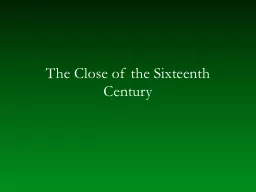

Developments in the Italian madrigal Scoring increase in number of voices five to six common Rhythm subtle treatment of diction Melody wider ranges for more expert singers ID: 252916
Download Presentation The PPT/PDF document "The Close of the Sixteenth Century" is the property of its rightful owner. Permission is granted to download and print the materials on this web site for personal, non-commercial use only, and to display it on your personal computer provided you do not modify the materials and that you retain all copyright notices contained in the materials. By downloading content from our website, you accept the terms of this agreement.
Slide1
The Close of the Sixteenth CenturySlide2
Developments in the Italian madrigal
Scoring —
increase in number of voices
(five to six
common)
Rhythm — subtle
treatment of diction
Melody —
wider ranges for more expert singers
Harmony —
more chromaticism for expressive effects
Form —
follows text
Text
treatment
more elaborate in
word painting —
melodic, rhythmic, textural devices
expression of feeling
—
harmonySlide3
Genres in Italian vocal music
Canzonetta —
light mood, simple style
Balletto —
dance-based
familiar style
—
simple and rhythmic
strophic with “fa-la” refrain
Villanella —
comic
employs compositional simplicity and crudity to suggest rustic classes
Madrigal
dialogue
—
madrigal with dialogue text, using subdivided ensemble to represent change of
speaker
Madrigal
comedy
—
a cycle of madrigals (more likely
villanelle)
featuring contrasting
ensembles and
constituting a storySlide4
Vocal music in England at the end of the sixteenth century
Affected
by Italy after period of isolation and conservatism
—
Nicholas Yonge,
Musica transalpina
(1588), acquainted English musicians with the latest Italian styles
Growth
of English poetry
—
period of Shakespeare
Modeled
on Italian genres
madrigal
—
style of best Italian madrigalists
Canzonet
Ballett
Songs
for voice and instruments
lute song
consort songSlide5
French mannerism
— focused on diction rather than expression
Pléiade poets (named for Greek poets of
third
century BCE)
—
most
famous was Pierre de Ronsard (1524
?–1585
)
promoted French over Latin for literary art
humanist interest in imitation of ancient literature
Jean-Antoine Baïf (
1532–1589
) founded Académie de poésie et de musique in 1570
applied
strict interpretation of Classic long and short syllables to poetry to produce
vers mesurée
Musique
mesurée
—
musical rhythm follows long and short syllables exactly, not necessarily regulated by equal measure lengthsSlide6
French songs for voice and lute
Vaudeville
(from
voix
de ville
,
“city
voice”)
—
more popular
Air
de cour
(court song)
—
courtly setting and sentimentSlide7
A “Venetian” scoring
Cori
spezzati
(spaced-out choirs)
—
polychoral scoring
remember antiphonal liturgical singing?
popular in northern Italy in general from fifteenth century
—
for special occasions
Associated
with St. Mark’s basilica in Venice
Adrian Willaert (ca.
1490–1562
)
—
Netherlander, maestro di cappella
Andrea Gabrieli (ca.
1510–1586
)
organist
; polychoral works published by nephew Giovanni in 1587 as
concerti
Giovanni Gabrieli (ca.
1553–1612
)
—
nephew of
Andrea;
organistSlide8
Questions for discussion
How did nonmusical
events
in history contribute to the new stylistic trends of the late sixteenth century? What purely musical forces shaped the development of these styles?
What aspects of the national character of Italy and France are embodied in the particular musical styles developed in each of those countries in the late sixteenth century?
Why is the
term
mannerist
sometimes applied to the music of this period?